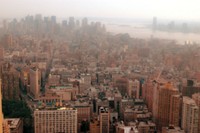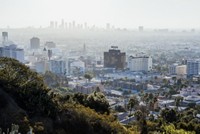Advertisement
Grab your lab coat. Let's get started
Welcome!
Welcome!
Create an account below to get 6 C&EN articles per month, receive newsletters and more - all free.
It seems this is your first time logging in online. Please enter the following information to continue.
As an ACS member you automatically get access to this site. All we need is few more details to create your reading experience.
Not you? Sign in with a different account.
Not you? Sign in with a different account.
ERROR 1
ERROR 1
ERROR 2
ERROR 2
ERROR 2
ERROR 2
ERROR 2
Password and Confirm password must match.
If you have an ACS member number, please enter it here so we can link this account to your membership. (optional)
ERROR 2
ACS values your privacy. By submitting your information, you are gaining access to C&EN and subscribing to our weekly newsletter. We use the information you provide to make your reading experience better, and we will never sell your data to third party members.
Environment
Ozone Conflict Rages
Industry, public health advocates clash over need for a more stringent standard
by Glenn Hess
November 10, 2014
| A version of this story appeared in
Volume 92, Issue 45

In the next few weeks, the Obama Administration will disclose whether it plans to tighten the federal air quality standard for ground-level ozone, the main component of lung-irritating smog. This outcome will be the latest twist in a years-long battle between proponents of stronger air pollution controls and industry groups, including chemical makers, that say further tightening of existing rules would hobble the economy.
Public health advocates and environmental activists say a stricter standard for ozone pollution is long overdue. “Ozone is the most widespread air pollutant and is known to cause coughing, wheezing, and asthma attacks,” says Janice E. Nolen, the American Lung Association’s assistant vice president of national policy and advocacy. New evidence links ozone to a broad array of other health threats as well, she adds, including cardiovascular harm, low birth weight in newborns, and loss of short-term memory.
But industry groups and some Republican members of Congress warn that a tougher limit on acceptable ozone levels would have a disastrous impact on the U.S. economy.
“Tightening the current ozone standard to near-unachievable levels would serve as a self-inflicted wound to the U.S. economy at the worst possible time,” says National Association of Manufacturers (NAM) Chief Executive Officer Jay Timmons.
A study NAM released in July says a stronger standard could carry a compliance price tag of as much as $2.2 trillion from 2017 to 2040, which would make it “the most expensive regulation the U.S. government has ever issued.”
The NAM study “validates our strong concern that radical revisions to EPA’s ozone standard could render much of the U.S. off-limits to manufacturing and bring our economy to a screeching halt,” says Calvin M. Dooley, CEO of the American Chemistry Council (ACC), a trade group that represents about 140 chemical companies.
The upcoming proposal from the Environmental Protection Agency will either ratchet down or retain the current standard of 75 ppb set under President George W. Bush in 2008. The Obama EPA is under court order to propose an ozone standard by Dec. 1 and to finalize it by Oct. 1, 2015.
Industry argues that EPA should focus on ensuring the entire country meets the 75-ppb standard before setting it any lower. “It’s vital that the Administration allow the existing ozone standard to be fully implemented rather than moving the goalposts with another set of requirements for manufacturers,” says Ross E. Eisenberg, NAM’s vice president of energy and resources policy. “Trillions of dollars are at stake.”
But EPA is widely expected to call for a stricter limit on ozone, which forms when hydrocarbon vapors and nitrogen oxides from vehicle tailpipes, power plants, and factories react in the presence of sunlight.
In August, a technical analysis by the agency’s Office of Air Quality Planning & Standards recommended that EPA Administrator Gina McCarthy greatly reduce the limit to somewhere between 60 and 70 ppb. A standard set within that range “could reasonably be judged to provide an appropriate degree of public health protection, including for at-risk populations,” such as children, older Americans, and those with respiratory impairments, the analysis concludes.
EPA’s Clean Air Scientific Advisory Committee, an independent panel of scientists, physicians, and air pollution experts, made a similar recommendation in June. But in a letter to McCarthy, the committee notes that there is “ample scientific evidence” that ozone is harmful at lower levels than previously thought. It cites studies showing ozone decreased lung function and increased respiratory symptoms and airway inflammation even at concentrations of 70 ppb.
The panel says that setting the standard at 60 ppb would “certainly offer more public health protection” than a standard of 70 ppb or 65 ppb and would provide an adequate margin of safety.
In a 2010 analysis, EPA estimated that an ozone standard of 60 ppb would save $100 billion a year in health care costs and eliminate as many as 12,000 premature deaths and 111,000 cases of respiratory symptoms by 2020.
The more stringent standard is needed to protect vulnerable populations, says Mary Anne Hitt, director of the Sierra Club’s Beyond Coal Campaign. “Scientists have shown that nothing above the 60-ppb level is safe, and 70 ppb is far too high if we intend to protect the lungs of young children and senior citizens,” she says.
Business groups, however, are concerned that a dramatically lower standard would trigger expensive new pollution control requirements for power plants and other industrial facilities, including chemical plants. EPA projects that the annual cost of scrubbing more ozone precursors out of the air to meet a 60-ppb standard could be $90 billion by 2020.
But NAM says that figure grossly underestimates damage the standard could do to the U.S. economy. The trade group’s analysis, prepared by NERA Economic Consulting, predicts that a 60-ppb standard would shut down one-third of the nation’s coal-fired power plant capacity, result in 2.9 million fewer jobs per year on average through 2040, and raise electricity costs for manufacturers and households alike. The analysis does not take potential public health benefits into account.
Under existing law, if a city or county exceeds EPA’s ozone standard, the agency declares it to be a “nonattainment” area. Such a designation requires state and local officials to take steps to further reduce pollution until the standard is met.
For example, Houston has not been able to comply with EPA’s current 75-ppb standard. Any company in the area that wants to expand or build a new facility must obtain emissions offsets to secure the air pollution permits it needs before starting construction.
“These offsets are difficult to attain, and they currently run in the neighborhood of $175,000 per ton of volatile organic chemicals or nitrogen oxide,” says Michael P. Walls, ACC’s vice president of regulatory and technical affairs. “A lower standard is sure to drive those costs up even more.”
The chemical industry is especially worried that a lower ozone standard could jeopardize its plan to spend more than $125 billion on new manufacturing capacity in the U.S. The investments, which include 44 projects worth $30 billion in Louisiana alone, seek to capitalize on the decline in energy prices brought about by the shale gas boom.
“Louisiana is an attractive place to invest, partly because every area of the state can meet the current ozone standard,” Walls says. But if EPA were to reduce the allowable level to 60 ppb, “all of Louisiana, along with most of the rest of the country, would be unable to meet it.”
Walls says it’s difficult to expand in nonattainment areas because of their more expensive and restrictive regulations. “It’s likely that facilities would expand only if they shut down some part of their operation or come up with the significant additional investment required to buy increasingly expensive offsets,” he says. “We are troubled by what could happen to business investment in the many new nonattainment areas that will emerge if EPA dramatically lowers the standard.”
The prospect of a more stringent standard has drawn strong opposition from Republicans on both sides of Capitol Hill. GOP lawmakers have introduced companion legislation (S. 2833, H.R. 5505) that would effectively block EPA from lowering the ozone limit until 85% of counties that are not now in compliance with the 75-ppb standard can meet the threshold. Currently, 221 counties in 27 states are considered nonattainment areas.
“The Obama EPA needs to focus its efforts on areas already struggling with attainment, not strangle American industry with a job-killing regulation,” says Sen. John Thune (R-S.D.), the chief sponsor of the Senate bill.
The legislation would also require EPA to take into account the feasibility and cost of lowering the ozone standard. The Clean Air Act now prohibits EPA from weighing costs when setting health-based air pollution standards.
“Improving air quality is a good goal,” says Rep. Pete Olson (R-Texas), who is sponsoring the bill in the House of Representatives. “But let’s balance the goal of improving air quality with the economic costs of achieving it.”
Supporters of a tougher ozone limit say industry groups have repeatedly overestimated the cost of complying with new air quality standards since Congress passed the Clean Air Act in 1970.
“History has shown time and time again that industry’s ‘the sky is falling’ predictions about the cost of clean air controls have been wrong,” says Frank O’Donnell, president of Clean Air Watch, a group that monitors air pollution and climate change policy. “There is no question in my mind that we can have cleaner air and a healthy economy—in fact, the two are complementary. There are many thousands of jobs associated with pollution cleanup,” he says.
Although public health experts say there is scientific justification for lowering the ozone standard to 60 ppb, O’Donnell suggests that the intense lobbying campaign by industry could affect the agency’s decision. “Don’t bet a lot on EPA setting the standard there,” he tells C&EN. “I wouldn’t.”




Join the conversation
Contact the reporter
Submit a Letter to the Editor for publication
Engage with us on Twitter